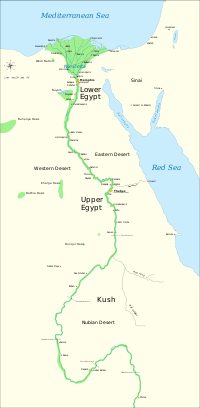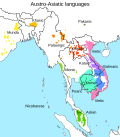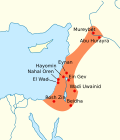Archaeogenetics is the study of ancient DNA using various molecular genetic methods and DNA resources. This form of genetic analysis can be applied to... 47 KB (5,810 words) - 05:21, 1 April 2024 |
 | Aboriginal Australians (redirect from Archaeogenetics of Australia) Oceania is estimated to have been between 60,000 and 40,000 years ago. Archaeogenetic results indicate a colonisation of southern Sahul (Australia) before... 74 KB (7,281 words) - 15:19, 14 April 2024 |
Genetics and archaeogenetics of South Asia is the study of the genetics and archaeogenetics of the ethnic groups of South Asia. It aims at uncovering these... 116 KB (12,183 words) - 18:16, 19 April 2024 |
 | Sub-Saharan Africa (redirect from Archaeogenetics of sub-Saharan Africa) Sub-Saharan Africa, Subsahara, or Non-Mediterranean Africa is the area and regions of the continent of Africa that lie south of the Sahara. These include... 198 KB (18,418 words) - 14:08, 23 April 2024 |
 | subject of research within the fields of human population genomics, archaeogenetics and Middle Eastern studies. Researchers use Y-DNA, mtDNA, and other... 95 KB (11,043 words) - 14:06, 20 April 2024 |
 | Neolithic Revolution (section Archaeogenetics) The Neolithic Revolution, also known as the First Agricultural Revolution, was the wide-scale transition of many human cultures during the Neolithic period... 96 KB (10,365 words) - 06:49, 23 April 2024 |
indigenous peoples of the Americas Genetic history of Europe Genetic history of Italy Genetics and archaeogenetics of South Asia Evolutionary biology portal... 68 KB (6,496 words) - 07:11, 12 April 2024 |
Genetic history of West Africa (redirect from Archaeogenetics of West Africa) The genetic history of West Africa encompasses the genetic history of the people of West Africa. The Sahara served as a trans-regional passageway and place... 27 KB (3,012 words) - 21:36, 10 March 2024 |
 | Parsis (section Archaeogenetics) The Parsis (singular: Parsi /ˈpɑːrsi/) or Parsees are an ethnoreligious group of the Indian subcontinent adhering to Zoroastrianism. They are descended... 92 KB (11,243 words) - 07:20, 23 April 2024 |
 | Paleo-Indians (section Archaeogenetics) Paleo-Indians were the first peoples who entered and subsequently inhabited the Americas during the final glacial episodes of the late Pleistocene period... 55 KB (4,988 words) - 22:01, 7 April 2024 |
 | Ancient Egypt (section Archaeogenetics) Ancient Egypt was a civilization of ancient Northeast Africa. It was concentrated along the lower reaches of the Nile River, situated in the place that... 138 KB (16,400 words) - 19:04, 19 April 2024 |
 | Illyrians (section Archaeogenetics) culture into the west Balkans has ever been found. Mathieson et al. 2018 archaeogenetic study included three samples from Dalmatia: two Early & Middle Bronze... 121 KB (14,650 words) - 22:01, 14 April 2024 |
 | The Austroasiatic languages (/ˌɒstroʊ.eɪʒiˈætɪk, ˌɔː-/ OSS-troh-ay-zhee-AT-ik, AWSS-) are a large language family spoken throughout mainland Southeast... 61 KB (5,681 words) - 11:43, 13 April 2024 |
Genetic history of North Africa (redirect from Archaeogenetics of North Africa) The genetic history of North Africa encompasses the genetic history of the people of North Africa. The most important source of gene flow to North Africa... 90 KB (10,247 words) - 22:39, 19 April 2024 |
 | Genetic history of Africa (redirect from Archaeogenetics of Africa) The genetic history of Africa summarizes the genetic makeup and population history of African populations in Africa, composed of the overall genetic history... 149 KB (15,991 words) - 00:14, 25 April 2024 |
Polynesians (redirect from Archaeogenetics of Polynesia) Polynesians are an ethnolinguistic group of closely related ethnic groups who are native to Polynesia (islands in the Polynesian Triangle), an expansive... 31 KB (2,580 words) - 19:20, 23 April 2024 |
Prehistoric Caucasus (redirect from Archaeogenetics of the Caucasus) The Caucasus region, on the gateway between Southwest Asia, Europe and Central Asia, plays a pivotal role in the peopling of Eurasia, possibly as early... 5 KB (547 words) - 14:50, 22 March 2024 |
 | Oceania (section Archaeogenetics) Oceania (UK: /ˌoʊsiˈɑːniə, ˌoʊʃi-, -ˈeɪn-/ OH-s(h)ee-AH-nee-ə, -AY-, US: /ˌoʊʃiˈæniə, -ˈɑːn-/ OH-shee-A(H)N-ee-ə) is a geographical region comprising... 342 KB (30,576 words) - 14:43, 22 April 2024 |
 | Andronovo culture (section Archaeogenetics) The Andronovo culture is a collection of similar local Late Bronze Age cultures that flourished c. 2000–1150 BC, spanning from the southern Urals to the... 63 KB (7,042 words) - 01:16, 21 April 2024 |
 | Ganj Dareh (section Archaeogenetics) Ganj Dareh (Persian: تپه گنج دره; "Treasure Valley" in Persian, or "Treasure Valley Hill" if tepe/tappeh (hill) is appended to the name) is a Neolithic... 17 KB (1,141 words) - 10:53, 27 March 2024 |
See Archaic humans in Southeast Asia for the earlier presence of archaic humans. Southeast Asia was first reached by anatomically modern humans possibly... 29 KB (3,132 words) - 19:58, 12 December 2023 |
Genetic history of Central Africa (redirect from Archaeogenetics of Central Africa) The genetic history of Central Africa encompasses the genetic history of the people of Central Africa. The Sahara served as a trans-regional passageway... 17 KB (1,690 words) - 04:48, 18 November 2023 |
 | not formally deposited within the settlement area.: 116 The first archaeogenetic analysis of Trypillian remains was conducted by Nikitin et al. in 2010... 97 KB (10,634 words) - 20:24, 20 March 2024 |
 | Natufian culture (section Archaeogenetics) instead were a mix of 50% Basal Eurasian ancestral component (see Archaeogenetics) and 50% West-Eurasian Unknown Hunter Gatherer (UHG) population related... 53 KB (5,690 words) - 09:24, 25 April 2024 |
Aconcagua mummy (section Archaeogenetics) The Aconcagua mummy is an Incan capacocha mummy of a seven-year-old boy, dated to around the year 1500. The mummy is well-preserved, due to the extreme... 11 KB (1,214 words) - 21:37, 9 April 2024 |
 | in Anatolia since at least the 19th century BCE. Recent advances in archaeogenetics have confirmed that the spread of agriculture from the Middle East... 72 KB (7,265 words) - 09:16, 22 April 2024 |
Tianyuan man (section Archaeogenetics) Tianyuan man (simplified Chinese: 田园洞人; traditional Chinese: 田園洞人; pinyin: Tiányuándòng Rén) are the remains of one of the earliest modern humans to inhabit... 14 KB (1,352 words) - 13:00, 15 April 2024 |



